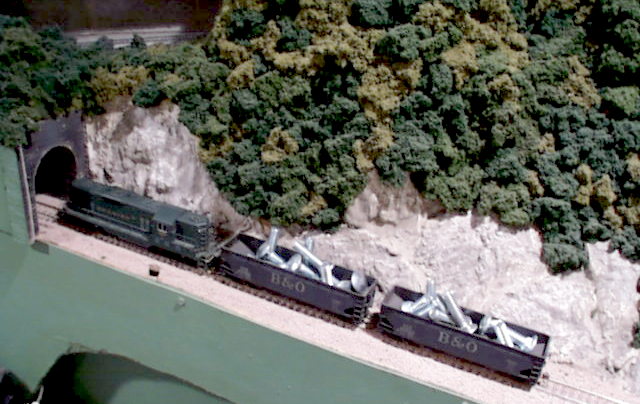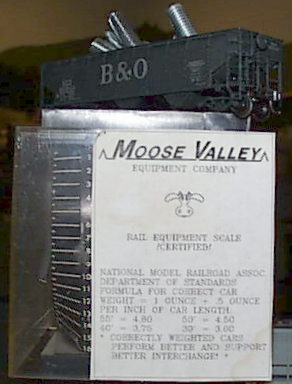

Overview:
The Moose Valley Railroad faces the same difficult challenges as real railroads, especially when operations are constrained to conform to the laws of physics. While scale model railroads deal with only a fraction of the weights and forces involved, they exist none the less. Real railroads assign locomotives to trains based on requirements established for getting trains over the line of road. One of the primary considerations for establishing these requirements, is locating the steepest and longest grade on the line. This section of track will present the most difficult obstacle for a train to surmount, because it will require the maximum in horsepower, adhesion, and metallurgical strength that any given train will possess. This climb is known as "the ruling grade", and is the primary consideration in assigning locomotives to a train.
Train Weight:
Each car on the Moose Valley system is inventoried, and measured. Several parameters are tracked, but the most important is weight. If the weight of the car is not known, it will not be possible to determine the requirements for overcoming the ruling grade. While rolling resistance is a factor in determining drag, it is not figured into the calculations. This is by convenience, and to keep the math simple. Each car is weighed with a postage scale. The weight of each car must conform to the NMRA recommended practice RP-20.1 and is entered into the roster with the final weight in ounces times 100. Therefore a 1.5 ounce car, becomes a 150 ton car. All the cars in a train are added together to equal the scale weight of a train. For example, a train with 10 300 ton cars, becomes a 3000 ton train.
Horsepower:
Each locomotive on the Moose Valley engine roster, has an assigned locomotive horsepower. This horsepower is directly related to the amount of scale ounces times 100 the locomotive in question can pull up the ruling grade. Because of the nature of the tests used to determine this amount, adhesion (which is the amount of available friction in the wheel to rail contact) is directly related to horsepower. For example, a locomotive which can pull 20 ounces up the ruling grade, will be assigned a horsepower rating of 2000.
The Equation:
Before a train is dispatched from the yard, a simple mathematical test is performed to see if the train has enough locomotives to pull the train over the ruling grade. The formula is (Total Horsepower [all engines added together]) - (Total train weight) = Surplus Horsepower. If the Surplus Horsepower number is positive, then the train will make it over the line of road. The greater the number, the easier the climb over the ruling grade will be. If the number is negative, then the train shouldn't leave the yard, or a helper locomotive with sufficient horsepower to make up the difference, will need to be dispatched from Berkeley Springs to meet the train at Hancock.
Weighing cars:
Obtaining the weight of a given car is a simple matter of putting it on a scale. For cars that are empty or loaded (coal hoppers), the empty weight is recorded. The loaded weight is arrived at an average weight milestone previously established by the mine. The allowable weight range is documented, and the number chosen to represent the loaded car is at the discretion of the mine crew. This does allow room for error. Consequently, coal drags with a low surplus horsepower number can still be surprised on the hill when their train stalls due to bad guesswork.
Rating Locomotives:
Horsepower ratings are obtained using a dynamometer of sorts. The locomotive is mated to two identical hopper cars of 20 ounce capacity. These cars are then filled with dedicated measuring units (carriage bolts) and the locomotive pulls the cars up the ruling grade until it stalls. Once the stall weight is obtained, bolts are removed until the locomotive is successful in making the climb. Each loaded hopper is then weighed, and the amounts added. The sum is multiplied by 100. This becomes the horsepower rating. So a locomotive with 10 ounces in one car, and 12 ounces in another car, becomes a 2200 horsepower locomotive.

This is the stall point. Locomotives which have reached their maximum
potential will usually start to slip here.
 The
loaded cars are then weighed on the postage scale. Note the NMRA formula
on the scale. This is the same scale used to weigh unloaded cars.
The
loaded cars are then weighed on the postage scale. Note the NMRA formula
on the scale. This is the same scale used to weigh unloaded cars.